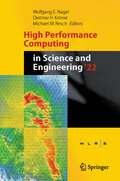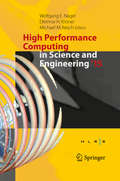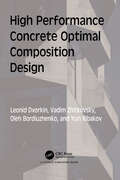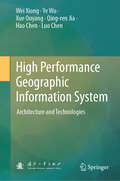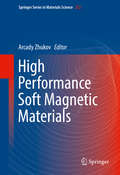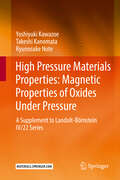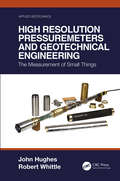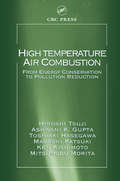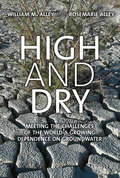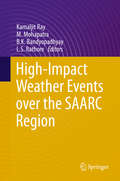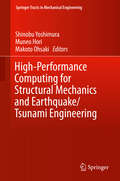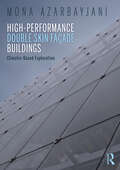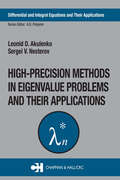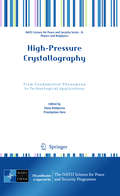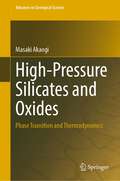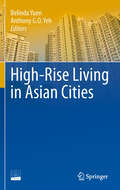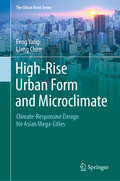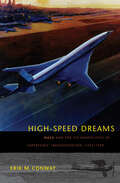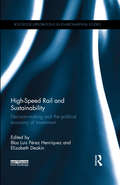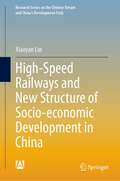- Table View
- List View
High Performance Computing in Science and Engineering '22: Transactions of the High Performance Computing Center, Stuttgart (HLRS) 2022
by Wolfgang E. Nagel Michael M. Resch Dietmar H. KrönerThis book presents the state-of-the-art in supercomputer simulation. It includes the latest findings from leading researchers using systems from the High Performance Computing Center Stuttgart (HLRS) in 2022. The reports cover all fields of computational science and engineering ranging from CFD to computational physics and from chemistry to computer science with a special emphasis on industrially relevant applications. Presenting findings of one of Europe’s leading systems, this volume covers a wide variety of applications that deliver a high level of sustained performance.The book covers the main methods in high-performance computing. Its outstanding results in achieving the best performance for production codes are of particular interest for both scientists and engineers. The book comes with a wealth of color illustrations and tables of results.
High Performance Computing in Science and Engineering ´15: Transactions of the High Performance Computing Center, Stuttgart (HLRS) 2015
by Wolfgang E. Nagel Michael M. Resch Dietmar H. KrönerThis book presents the state-of-the-art in supercomputer simulation. It includes the latest findings from leading researchers using systems from the High Performance Computing Center Stuttgart (HLRS) in 2015. The reports cover all fields of computational science and engineering ranging from CFD to computational physics and from chemistry to computer science with a special emphasis on industrially relevant applications. Presenting findings of one of Europe’s leading systems, this volume covers a wide variety of applications that deliver a high level of sustained performance. The book covers the main methods in high-performance computing. Its outstanding results in achieving the best performance for production codes are of particular interest for both scientists and engineers. The book comes with a wealth of color illustrations and tables of results.
High Performance Computing in Science and Engineering ´16: Transactions of the High Performance Computing Center, Stuttgart (HLRS) 2016
by Wolfgang E. Nagel Michael M. Resch Dietmar H. KrönerThis book presents the state-of-the-art in supercomputer simulation. It includes the latest findings from leading researchers using systems from the High Performance Computing Center Stuttgart (HLRS) in 2016. The reports cover all fields of computational science and engineering ranging from CFD to computational physics and from chemistry to computer science with a special emphasis on industrially relevant applications. Presenting findings of one of Europe’s leading systems, this volume covers a wide variety of applications that deliver a high level of sustained performance.The book covers the main methods in high-performance computing. Its outstanding results in achieving the best performance for production codes are of particular interest for both scientists and engineers. The book comes with a wealth of color illustrations and tables of results.
High Performance Computing in Science and Engineering ‘12
by Wolfgang E. Nagel Michael M. Resch Dietmar H. KrönerThis book presents the state-of-the-art in simulation on supercomputers. Leading researchers present results achieved on systems of the High Performance Computing Center Stuttgart (HLRS) for the year 2012. The reports cover all fields of computational science and engineering ranging from CFD via computational physics and chemistry to computer science with a special emphasis on industrially relevant applications. Presenting results for both vector-systems and micro-processor based systems the book allows to compare performance levels and usability of various architectures. As HLRS operates not only a large cluster system but also one of the largest NEC vector systems in the world this book gives an excellent insight also into the potential of vector systems. The book covers the main methods in high performance computing. Its outstanding results in achieving highest performance for production codes are of particular interest for both the scientist and the engineer. The book comes with a wealth of coloured illustrations and tables of results.
High Performance Concrete Optimal Composition Design
by Leonid Dvorkin Vadim Zhitkovsky Yuri Ribakov Oleh BordiuzhenkoConcrete and reinforced concrete remain the main building materials for construction of modern fortifications. The book presents experimental and theoretical results allowing production of special high-strength rapid hardening concrete and fiber reinforced concrete. It describes a method for effective proportioning of high-strength fast-setting concrete and fiber reinforced concrete with high dynamic strength as well as selecting proper technological parameters, methodology for design of reinforced concrete structures using such concrete. Particular attention is paid to ensuring the early strengthening of concrete within 24 hours after casting and to constructing structures with limited energy resources at the site.
High Performance Geographic Information System: Architecture and Technologies
by Wei Xiong Hao Chen Ye Wu Xue Ouyang Qing-ren Jia Luo ChenThe development of earth observation and computing technology has promoted the wide application of spatio-temporal big data and artificial intelligence. The enrichment of data and the improvement of computational performance make it possible to perform spatio-temporal analysis and computation on a larger scale. Therefore, it is necessary to study the optimization methods and application methods of high-performance geocomputing, starting from GIS architecture, in order to form a high-performance GIS that can serve the society and economy and support various applications. This book focuses on the architecture, technology, platform, and application of high-performance GIS, analyzes the key technologies of spatio-temporal big data organization and access, parallelized spatial analysis and processing, large-scale map rendering, and parallel visualization under the high-performance computing architecture, explains how to build high-performance geographic information applications, and looks forward to the trend of the new generation of GIS.
High Performance Soft Magnetic Materials
by Arcady ZhukovThis book provides comprehensive coverage of the current state-of-the-art in soft magnetic materials and related applications, with particular focus on amorphous and nanocrystalline magnetic wires and ribbons and sensor applications. Expert chapters cover preparation, processing, tuning of magnetic properties, modeling, and applications. Cost-effective soft magnetic materials are required in a range of industrial sectors, such as magnetic sensors and actuators, microelectronics, cell phones, security, automobiles, medicine, health monitoring, aerospace, informatics, and electrical engineering. This book presents both fundamentals and applications to enable academic and industry researchers to pursue further developments of these key materials. This highly interdisciplinary volume represents essential reading for researchers in materials science, magnetism, electrodynamics, and modeling who are interested in working with soft magnets.
High Pressure Materials Properties: A Supplement to Landolt-Börnstein IV/22 Series
by Yoshiyuki Kawazoe Ryunosuke Note Takeshi KanomataThe subject of this supplement to Landolt-Börnstein IV/22 Series is to present both the numerical and graphical data on the various magnetic properties of materials under pressure. Data for transition metal binary oxides MmOn [M: transition metals, O: oxygen, m, n: 1~15], MXO [M: transition metals, X: F, Cl, Br, O: oxygen] and MM’On [M: transition metals, M’: transition metals or non-transition metal elements, O: oxygen, n=2, 2.5, 3] ternary oxides are presented.As well known, the data-compiling principle in the Landolt-Bӧrrnstein series is to choose the best reliable values from many available experimental data. The present compilation is done according to this principle.
High Resolution Pressuremeters and Geotechnical Engineering: The Measurement of Small Things (Applied Geotechnics Ser.)
by John Hughes Robert WhittleHigh Resolution Pressuremeters and Geotechnical Engineering focuses on pressuremeters with internal transducers that allow measurement of strength, stiffness and in situ reference stress. It outlines the principles and the basics of the technology, gives guidance on good practice and making reliable analysis, provides case studies, and compares the pressuremeter test with similar ones from other devices to enable engineers to make informed choices. A unique, up-to-date guide to high resolution pressuremeters with internal transducers Contextualises analyses and advice to enable an informed choice of testing processes Presents analyses previously unpublished in book form This practical guide will suit professionals at the consultancy level, pressuremeter practitioners and site investigation companies.
High Strength Support for Soft Surrounding Rock in Deep Underground Engineering: Theory and Key Technology
by Qi Wang Bei Jiang Shucai LiThis book examines the field of surrounding rock control mechanisms and support technologies in underground engineering, and proposes a high-strength support system to address the complex conditions in underground engineering, such as high stress, extremely soft rocks, fault fracture zone and strong mining activity. It also comprehensively discusses the concept and bearing mechanisms of the supporting system, design calculation methods, field application and key construction technologies. The book describes the design and construction of a large-scale mechanical test system, independently developed by the author for high- strength confined concrete arches, which can also be used to define the mechanism of deformation and failure of confined concrete arches. Further, the book explores the application of the confined concrete support system in underground engineering with complex conditions, and its control effect on soft surrounding rock.The first international book presenting the theory and key technologies of high-strength, confined concrete support, it is a valuable reference resource for design, construction and supervision staff in the field of geotechnical engineering, as well as for teachers, students and researchers.
High Temperature Air Combustion: From Energy Conservation to Pollution Reduction
by Hiroshi Tsuji Ashwani K. Gupta Toshiaki Hasegawa Masashi Katsuki Ken Kishimoto Mitsunobu MoritaMaximize efficiency and minimize pollution: the breakthrough technology of high temperature air combustion (HiTAC) holds the potential to overcome the limitations of conventional combustion and allow engineers to finally meet this long-standing imperative. Research has shown that HiTAC technology can provide simultaneous reduction of CO2 and nitric
High and Dry: Meeting the Challenges of the World's Growing Dependence on Groundwater
by William M. Alley Rosemarie AlleyAn engaging call to understand and protect groundwater, the primary source of drinking water for almost half of the world's population Groundwater is essential for drinking water and food security. It provides enormous environmental benefits by keeping streams and rivers flowing. But a growing global population, widespread use of industrial chemicals, and climate change threaten this vital resource. Groundwater depletion and contamination has spread from isolated areas to many countries throughout the world. In this accessible and timely book, hydrology expert William M. Alley and science writer Rosemarie Alley sound the call to protect groundwater. Drawing on examples from around the world, including case studies in the United States, Canada, Australia, India, and Sub-Saharan Africa, the authors examine groundwater from key scientific and socioeconomic perspectives. While addressing the serious nature of groundwater problems, the book includes stories of people who are making a difference in protecting this critical resource.
High-Hanging Fruit: Build Something Great by Going Where No One Else Will
by Mark RampollaSO OFTEN IN BUSINESS, WE'RE ENCOURAGED TO GO AFTER THE LOW-HANGING FRUIT. BUT WHEN YOU CHOOSE TO REACH HIGHER, YOU CAN BUILD AN INCREDIBLE BUSINESS, MAKE MONEY, AND MAYBE EVEN CHANGE THE WORLD. In 2004, Mark Rampolla had made it. He was making $300,000 a year, traveling the world with his family, and poised to rise to the top of a Fortune 100 company. There was just one problem: He wasn't inspired in his job and believed he had something more to offer the world. He started dreaming of start-up ideas. Though many had big profit potential, they all sounded boring and soulless. So he started thinking differently. He stopped obsessing over "How much money will this make me?" and instead asked, "What do I have to offer that will improve the world?" Suddenly Rampolla realized that his big idea was hanging right overhead. From his time in the Peace Corps and now living in Central America, he and his family came to love drinking coconut water, just like the locals. But no one was really selling coconut water in the United States. So Rampolla chased a very ambitious goal: introducing coconut water to the American market on the already crowded beverage shelf dominated by a few big players. He wasn't just starting a business; he was creating a whole new industry. ZICO Coconut Water brought a healthy beverage alternative to American consumers while also helping developing-world growers and suppliers profit from this resource. Within nine years it was a win-win-win--good for Rampolla, his customers, and the world. So good, in fact, that in 2013 The Coca-Cola Company purchased ZICO and is in the process of scaling the brand around the globe. Rampolla wrote High-Hanging Fruit for others who want to succeed because of, not in spite of, their values. This book is for people who believe that it's their duty to reach higher than just the bottom line to build businesses driven by passion, purpose, and integrity. Above all, it's a call to arms for a new generation of entrepreneurs who want to disrupt the old model and do good by doing business. From the Hardcover edition.
High-Impact Weather Events over the SAARC Region
by L. S. Rathore Kamaljit Ray M. Mohapatra B. K. BandyopadhyayThis book is a compilation of papers contributed by researchers and scientists from SAARC nations and deals with high-impact weather conditions, their prediction and potential consequences for populations in the SAARC region. There have been a number of recent advances in our understanding and prediction of cyclones, severe thunderstorms, squalls, heat and cold waves, droughts and heavy rainfall, based on the latest observational data and NWP modeling platform. The SAARC region is vulnerable to high-impact weather events because of geophysical features like high mountains, plateaus and vast oceans. As our climate continues to change over the coming years, the likelihood of extreme and potentially high-impact weather and climate events will be at its highest when natural and anthropogenic effects combine. All chapters were written by leading experts in their respective research and operational fields. The book reviews the latest research, future needs, forecasting skills and societal impacts of extreme weather events and offers high-quality reference material for weather forecasters, disaster managers and researchers.
High-Performance Computing for Structural Mechanics and Earthquake/Tsunami Engineering
by Makoto Ohsaki Shinobu Yoshimura Muneo HoriHuge earthquakes and tsunamis have caused serious damage to important structures such as civil infrastructure elements, buildings and power plants around the globe. To quantitatively evaluate such damage processes and to design effective prevention and mitigation measures, the latest high-performance computational mechanics technologies, which include telascale to petascale computers, can offer powerful tools. The phenomena covered in this book include seismic wave propagation in the crust and soil, seismic response of infrastructure elements such as tunnels considering soil-structure interactions, seismic response of high-rise buildings, seismic response of nuclear power plants, tsunami run-up over coastal towns and tsunami inundation considering fluid-structure interactions. The book provides all necessary information for addressing these phenomena, ranging from the fundamentals of high-performance computing for finite element methods, key algorithms of accurate dynamic structural analysis, fluid flows with free surfaces, and fluid-structure interactions, to practical applications with detailed simulation results. The book will offer essential insights for researchers and engineers working in the field of computational seismic/tsunami engineering.
High-Performance Double Skin Façade Buildings: Climatic-Based Exploration
by Mona AzarbayjaniThis book provides a comprehensive theoretical platform for the use and construction of double skin façade projects. The DSF concept has been used mostly in European buildings; however, its success in other climates should be addressed. Increasing numbers of buildings are featuring double skin façade technology in the US; however, still relatively few have been studied for their performance in operation. This book gives architects a practical guide to analyze and evaluate the actual performance of double skin façade buildings in different climatic contexts. It is important for high-performance buildings to have tools to evaluate a design’s predicted performance to achieve specific sustainable goals. To determine that the application of DSF in different climates will provide better thermal comfort, building simulation tools analyze various thermal comfort parameters through studies of the façade and compare them with the actual building’s performance data. The book takes the reader on an on-site tour of eight DSF buildings around the US. Interviews with the buildings’ architects and engineers, owners, and users offer additional perspectives and insights into the construction and performance of these developments in building design. This will provide architects with a comprehensive understanding of the challenges and opportunities in integrating double skin façades into their projects.
High-Performance Double Skin Façade Buildings: Climatic-Based Exploration
by Mona AzarbayjaniThis book provides a comprehensive theoretical platform for the use and construction of double skin façade projects. The DSF concept has been used mostly in European buildings; however, its success in other climates should be addressed. Increasing numbers of buildings are featuring double skin façade technology in the US; however, still relatively few have been studied for their performance in operation.This book gives architects a practical guide to analyze and evaluate the actual performance of double skin façade buildings in different climatic contexts. It is important for high-performance buildings to have tools to evaluate a design’s predicted performance to achieve specific sustainable goals. To determine that the application of DSF in different climates will provide better thermal comfort, building simulation tools analyze various thermal comfort parameters through studies of the façade and compare them with the actual building’s performance data. The book takes the reader on an on-site tour of eight DSF buildings around the US. Interviews with the buildings’ architects and engineers, owners, and users offer additional perspectives and insights into the construction and performance of these developments in building design.This will provide architects with a comprehensive understanding of the challenges and opportunities in integrating double skin façades into their projects.
High-Precision Methods in Eigenvalue Problems and Their Applications
by Leonid D. Akulenko Sergei V. NesterovThis book presents a survey of analytical, asymptotic, numerical, and combined methods of solving eigenvalue problems. It considers the new method of accelerated convergence for solving problems of the Sturm-Liouville type as well as boundary-value problems with boundary conditions of the first, second, and third kind. The authors also present high
High-Pressure Crystallography
by Elena Boldyreva Przemyslaw DeraThis book is devoted to the theme of crystallographic studies at high pressure, with emphasis on the phenomena characteristic to the compressed state of matter, as well as experimental and theoretical techniques, used to study these phenomena. As a thermodynamic parameter, pressure is remarkable in many ways. It spans in the visible universe over sixty orders of magnitude, from the non-equilibrium pressure of hydrogen in intergalactic space, to the kind of pressure encountered within neutron stars. In laboratory, it provides unique possibility to control structure and properties of materials, dramatically alter electronic properties, break existing, or form new chemical bonds. This agenda naturally encompasses elements of physics (properties, structure and transformations), chemistry (reactions, transport), materials science (new materials) and engineering (mechanical properties); in addition it has direct applications and implications for geology (minerals in deep Earth environments), planetary sciences, biology and medicine (deep sea ecosystems, membranes, protein and nucleic acid folding, origins of life, deactivation of viruses and toxins). Beyond its specificity, high-pressure science finds direct or indirect (e.g. economic) applications in several fields of modern technology, such as mechanical engineering, optoelectronics and spintronics, nanotechnology, pharmaceutical industry and food processing.
High-Pressure Silicates and Oxides: Phase Transition and Thermodynamics (Advances in Geological Science)
by Masaki AkaogiThis book presents a summary of high-pressure phase transitions of minerals and related inorganic compounds. The first part reviews the methods to investigate phase transitions by direct high-pressure and high-temperature experiments together with thermodynamic approaches that consist of calorimetric measurements and thermodynamic calculation. In the second part, phase relations and thermodynamic properties of olivine, pyroxene, garnet, spinel, perovskite, rutile, and related inorganic compounds with A2BO4, ABO3, AB2O4, and AO2 stoichiometries are described. Particular emphasis is placed on spinel- and perovskite-structured phases and their high-pressure polymorphs called post-spinel and post-perovskite phases. The last part of the book focuses on phase relations of mantle rocks and on natural high-pressure minerals from the Earth’s deep mantle and in shocked meteorites.
High-Rise Living in Asian Cities
by Anthony G.O. Yeh Belinda YuenThis book is intended to fill a knowledge gap in the study of contemporary high-rise living. While there has been much documentation on the engineering and technological aspects of tall buildings, relatively little has been written about the social and livability of high-rise. Much less is written about Asian cities even though Asia is the current hotbed of high-rise development. Even though traditional discourse of high-rise housing is not always positive, new forces are redefining its place in 21st century urbanity. Many cities around the world are reembracing high-rise in urban agenda under current narrative of sustainable development. High-rise is fast becoming a priority area in international research agenda. The quest is for livable and sustainable high-rise development. Against the background of current trends--globalization, urbanization, mixed-use development, and new-built taller buildings in inner city areas in both developed and developing countries, this book examines the software: design, economics, estate management, legal and property rights, physical environment, planning, community development, and social dimensions of high-rise living. Analysis is with the widely acclaimed successful high-rise public housing in Hong Kong and Singapore to understand the advantages and worries of high-rise living, and to distill the key points and lessons in the making of a 'good' highrise living environment. Hong Kong and Singapore have been constructing high-rise for more than four decades each. The majority of their population has moved to live in high-rise, selecting to live high-rise, and registering consistently high residential satisfaction. The height of apartment buildings in both cities continues to rise. The tallest is anticipated to be 70-storey. It is the contention of this book that contrary to earlier common negative discourses on public high-rise living, the high-rise environment may yet offer urban residents a satisfying dwelling experience. Leading housing academics, researchers and practitioners in the two cities have contributed to this book. This book presents a timely contribution to our understanding of a widening urban phenomenon that will affect a growing number of the world's population.
High-Rise Urban Form and Microclimate: Climate-Responsive Design for Asian Mega-Cities (The Urban Book Series)
by Feng Yang Liang ChenThe book comprehensively investigates the relationship between critical urban form and fabric parameters and urban microclimate in the high-rise urban environment that prevails in Asian megacities such as Shanghai. It helps readers gain a deeper understanding of climate-responsive urban design strategies and tactics for effectively mitigating the negative impacts of deteriorating urban thermal environments on pedestrian thermal comfort, outdoor air quality and building energy consumption. It also reviews the latest advances in urban climate research, with a focus on the challenges in terms of outdoor space comfort, health, and livability posed by the high-rise and high-density development in emerging Asian megacities, and proposes an integrated framework in response to the pressing need for microclimate research. It then presents a series of studies on high-rise residential and non-residential urban neighborhoods and districts based on instrumented field study, validated numerical simulation, and spatial analysis using a GIS platform. The book includes extensive, valuable experimental data presented in a clear and concise manner. The thermal atlas methodology based on empirical modeling and spatial analysis described is a useful climate-responsive design tool for both urban designer and architects. As such, the book is of particular interest to researchers, professionals, and graduate students in the fields of urban planning and design, building science and urban climatology.
High-Speed Dreams: NASA and the Technopolitics of Supersonic Transportation, 1945–1999 (New Series in NASA History)
by Erik M. ConwayIn High-Speed Dreams, Erik M. Conway constructs an insightful history that focuses primarily on the political and commercial factors responsible for the rise and fall of American supersonic transport research programs. Conway charts commercial supersonic research efforts through the changing relationships between international and domestic politicians, military/NASA contractors, private investors, and environmentalists. He documents post-World War II efforts at the National Advisory Committee on Aeronautics and the Defense Department to generate supersonic flight technologies, the attempts to commercialize these technologies by Britain and the United States during the 1950s and 1960s, environmental campaigns against SST technology in the 1970s, and subsequent attempts to revitalize supersonic technology at the end of the century.High-Speed Dreams is a sophisticated study of politics, economics, nationalism, and the global pursuit of progress. Historians, along with participants in current aerospace research programs, will gain valuable perspective on the interaction of politics and technology.
High-Speed Rail and Sustainability: Decision-making and the political economy of investment (Routledge Explorations in Environmental Studies)
by Blas Luis Pérez Henríquez Elizabeth DeakinHigh speed rail (HSR) is being touted as a strategic investment for connecting people across regions, while also fostering prosperity and smart urban growth. However, as its popularity increases, its implementation has become contentious with various parties contesting the validity of socioeconomic and environmental objectives put forward as justification for investment. High Speed Rail and Sustainability explores the environmental, economic and social effects of developing a HSR system, presenting new evaluations of the proposed system in California in the US as well as lessons from international experience. Drawing upon the accumulated experience from past HSR system development around the world, leading experts present a diverse set of perspectives as well as diverse contexts of implementation. Assessments of the California case as well as cases from Japan, France, Germany, Italy, Spain, Taiwan, China, and the UK show how governments and stakeholders have bridged the gap between the vision and the realities of connecting metropolitan regions through HSR. This is a valuable resource for academics, researchers and policy-makers in the areas of urban planning, civil engineering, transportation and environmental design.
High-Speed Railways and New Structure of Socio-economic Development in China (Research Series on the Chinese Dream and China’s Development Path)
by Xiaoyan LinThis book systematically expounds the significance of the high-speed railway in China's regional economic and social development. It also contains a large number of case discussions, so that readers can fully understand the development of China's high-speed railway and its role in promoting China's economy. The purpose of this book is to determine whether high-speed railway has important political and strategic significance for China's development, the inherent relationship and mechanism of the high-speed railway together with economic and social development, and how to achieve the high-speed rail and economic and social coordination, as well as sustainable development.
